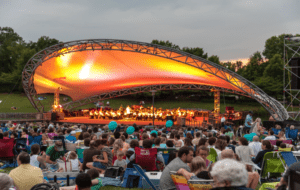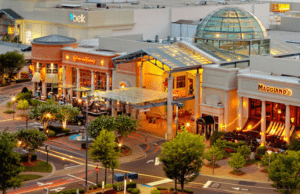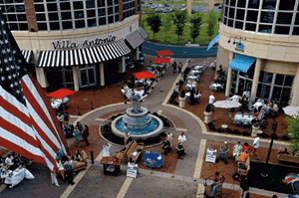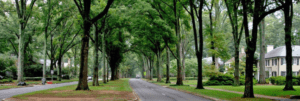Top Story
Date: March 13-18, 2016
Location: Charlotte, North Carolina
Sponsor: The City of Charlotte, Mecklenburg County, Lincoln Harris, SyncoProperties, Childress Klein, Coca Cola Bottling Co. Consolidated, National Gypsum, Nucor, Pappas Properties, Piedmont Natural Gas, Renaissance Charlotte, SouthPark Hotel, Liberty Healthcare Management
Subject Area: Neighborhood Redevelopment, Placemaking
Panel Chair: Ed McMahon, Urban Land Institute, Washington D.C.
Background and Panel Assignment
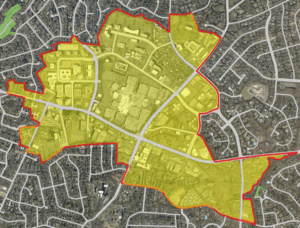 SouthPark, a suburban activity center six miles south of downtown Charlotte, is made up of different commercial, retail, and residential nodes. Originally dairy farmland, SouthPark was transformed in the 1970s with the construction of the SouthPark Mall, a commercial economic engine that now serves as the areas’ anchor. Through the late 20th century, the mall continued to expand and reinvent itself to the changing economic market. Following the mall’s success, different office developments and multi-family, as well as single family neighborhoods started populating the surrounding area.
SouthPark, a suburban activity center six miles south of downtown Charlotte, is made up of different commercial, retail, and residential nodes. Originally dairy farmland, SouthPark was transformed in the 1970s with the construction of the SouthPark Mall, a commercial economic engine that now serves as the areas’ anchor. Through the late 20th century, the mall continued to expand and reinvent itself to the changing economic market. Following the mall’s success, different office developments and multi-family, as well as single family neighborhoods started populating the surrounding area.
While SouthPark has historically been an office and retail location, the study area is currently in a significant phase of its evolution. Current development is transforming this suburban activity center to an urban activity center. However, due to the changing trends in development and redevelopment, the community’s desire to protect the existing surrounding single family character, and the increased infrastructure demands, SouthPark requires a comprehensive strategy to sustain and strength the areas future as a premier Charlotte community to live, work, play and invest.
Summary of Recommendations
To retain SouthPark’s unique product, the panel recommends the following to promote sustainable development, livability, and economic growth in the region:
- Create a shared vision for the future. SouthPark has the option of either creating a future it wants or accepting the future it is given. To ensure long-term growth and improvement, the panel suggests SouthPark develop a development vision of its future.
- Speak with one voice. In many ways, the city and the county have taken SouthPark for granted by simply assuming it could take care of itself. SouthPark, unlike Uptown, has failed to speak with one voice. SouthPark’s neighbors, residents, businesses, and landowners all have similar concerns, but they do not work together or speak with one voice.
- Take small steps to make big changes. Many communities hold the common misconception that meaningful transformation always requires one big thing. The panel’s experience has found that successful communities often “think small in a big way.” The panel believes that SouthPark could make big changes for the better with a series of smaller, incremental steps.
- Create a stronger identity and a heart and soul. To stay successful, SouthPark has to be more than simply a suburban office and business hub. SouthPark can be a dynamic, live/work/play environment (urban center), but to accomplish this goal, it needs a stronger identity and an expanded set of amenities. Other than the mall, SouthPark lacks a focal point. It also lacks parks, public gathering places, and arts and cultural facilities. Like every community, SouthPark has a history, but the SouthPark story has been lost amid the shopping centers, office buildings, and parking lots.
- Design for people, not cars. Although SouthPark has a variety of high-quality development projects, these projects are isolated and disconnected from each other. Moving among these places almost always requires a car, as does traveling from the adjacent neighborhoods to the mall or other retail destinations. Stronger connections create better places and reduce traffic congestion, a large issue voiced by the community. Experience in other cities has demonstrated that if a place is designed around cars, cars and congestion will increase; but if a place is designed around people, more people will arrive and move without a car. In addition, walkability fosters profitability. Walkable neighborhoods are places where people stay longer, come back more often, and spend more money. In real estate, this is known as the “placemaking dividend.”
- Connect people and places. SouthPark needs more pocket parks and green spaces where both children and adults feel welcome. Creating more public gathering places and a high-quality environment for pedestrians and other forms of nonmotorized transportation will be good for business, the environment, health, and the image and identity of SouthPark.
- Create a SouthPark partnership. SouthPark needs a vehicle for convening its stakeholders. SouthPark also needs an organization or partnership to provide leadership, a unified voice, a higher profile, and a financial method (such as tax increment financing, tax increment grant, business improvement district, and the like) for implementing its strategic vision, to capture some of the value created by future development and redevelopment and to invest in its infrastructure and public realm.
- Use public/private partnership and funding. The panel’s stakeholder interviews found that the various groups with a stake in the future of SouthPark (i.e., business owners, developers, office tenants, neighbors, and new residents) all share a common set of concerns. However, these stakeholders rarely come together to focus on what they agree on. More commonly, the only time they convene is as opponents at a public hearing about a proposed project or rezoning. Creating a formal process or partnership to identify concerns will help consolidate resources to address issues more effectively.
- Raise the bar and expect better. The panel asks the city of Charlotte to demand better design and building practices from developers that would benefit overall from improved walkability and livability in the SouthPark area.
- Build housing for everyone. SouthPark’s surrounding neighborhoods are mostly homogenous in both race and income. The panel recognizes the limited resources of the nearby school districts and encourages building more housing options for demographics such as senior citizens in SouthPark. In addition, workforce housing needs to be incorporated in both long- and short-term development in the study area.
